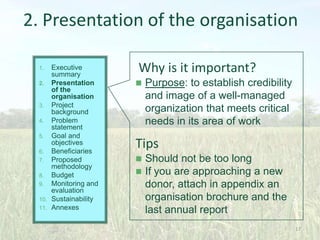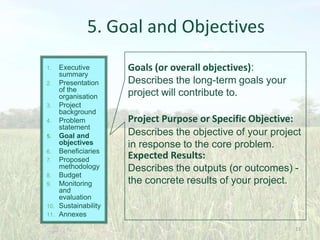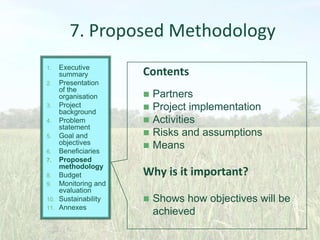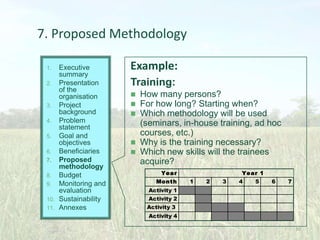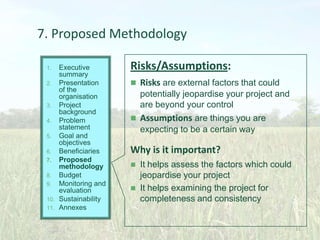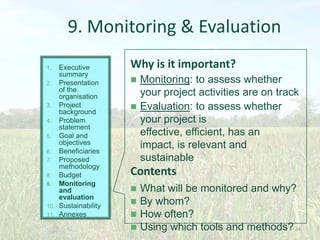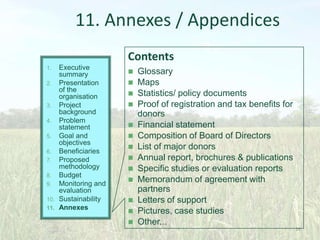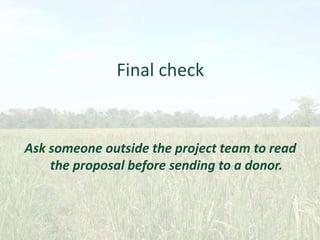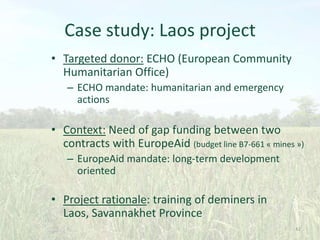10 Project Proposal Writing
- 1. Writing Proposals with a logical framework
- 2. Welcome This is a course on writing effective project proposals. You should have already learnt about pre-planning and logical frameworks.
- 3. What is a proposal? • Your proposal is an important document • Donors will decide to finance your project or not from what they read. • Any proposal should show thoughtful planning
- 4. Identify the project idea • Do your Pre-Planning and Stakeholders Analysis • Look at possible funding and local resources • What you learn from this will point you in the direction of the best way to help - the ‘project approach’ and ‘project logic’
- 5. Identify the project idea • Your pre-planning should have pointed to an approach that fits into this model: Community demand Project Needs identified by experts Available resources
- 6. Good ideas 1. Make sure there is a genuine problem and that you can face it. 2. Two-step approach: o First define your project thoroughly and using a participatory approach, o Then adapt your project proposal according to the targeted donor. 3. Use the logical framework - a tool to design a project in a systematic and logical way .
- 8. Find the right funding source • Which donor has a target compatible with your project ? e.g. Humanitarian aid or development - ECHO, EuropeAid Refugees - Austcare HIV, Malaria - Global Fund • What are your potential donors preferences? e.g. Mines victims - Irish Aid Institutional strengthening - AusAID • How does each donor evaluate project proposals? Are you likely to be selected? ‒ – Is there an evaluation grid ? Do they require a partnership? Gender equity? What?
- 9. Remember o Your Proposal is often the only way for the donor to choose or reject your project o Write a proposal only when your project idea is already well thought out o Fit to the donor’s guidelines
- 10. Package your project into an attractive proposal (1) • Follow a logical thread: Background Problem Solution Sustainability • Ensure match-up between: Problem – Outcomes – Means (this is called internal coherence) • Many donors want the Logical Framework Approach
- 11. Package your project into an attractive proposal (2) • • • • • Logic checklist Don’t leave a problem unsolved Don’t identify outcomes that do not correspond to a problem Don’t identify outcomes for which you don’t have a solution Don’t propose activities that are not related to problems and outcomes Don’t list human resources that don’t match the outcomes you aim to achieve
- 12. Package your project into an attractive proposal (3) Editing and layout Pay attention to the language: - Use simple language - Use future tenses - Be concise and logical - Avoid spelling mistakes - Find a catchy title Pay attention to the layout / presentation: - Use your organization’s logo on the first page - Use headers and footers - Use clear titles and paragraphs - Break the monotony - Add table of contents - Print on standard format paper
- 13. Proposal structure 1. 2. 3. 4. 5. 6. 7. 8. 9. 10. 11. Executive Summary Organisation description Project background Problem statement Goal and objectives Beneficiaries Proposed methodology: Partners Project implementation Activities Risks and assumptions Means Budget Monitoring and Evaluation Sustainability Annexes
- 14. 1. Executive Summary Executive summary 2. Presentation of the organisation 3. Project background 4. Problem statement 5. Goal and objectives 6. Beneficiaries 7. Proposed methodology 8. Budget 9. Monitoring and evaluation 10. Sustainability 11. Annexes 1. Why is it important: It is the first part that is read Sometimes the only part that is read… It can be used by the donor to communicate to others about your project 14
- 15. 1. Executive Summary Executive summary 2. Presentation of the organisation 3. Project background 4. Problem statement 5. Goal and objectives 6. Beneficiaries 7. Proposed methodology 8. Budget 9. Monitoring and evaluation 10. Sustainability 11. Annexes 1. Summary What do you propose to do? Where? Why? For whom? With whom? For how long? 15
- 16. 1. Executive Summary Executive summary 2. Presentation of the organisation 3. Project background 4. Problem statement 5. Goal and objectives 6. Beneficiaries 7. Proposed methodology 8. Budget 9. Monitoring and evaluation 10. Sustainability 11. Annexes 1. DO : Write it last Do it carefully Keep it short DON’T : Cut and paste 16
- 17. 2. Presentation of the organisation Executive summary 2. Presentation of the organisation 3. Project background 4. Problem statement 5. Goal and objectives 6. Beneficiaries 7. Proposed methodology 8. Budget 9. Monitoring and evaluation 10. Sustainability 11. Annexes 1. Why is it important? Purpose: to establish credibility and image of a well-managed organization that meets critical needs in its area of work Tips Should not be too long If you are approaching a new donor, attach in appendix an organisation brochure and the last annual report 17
- 18. 2. Presentation of the organisation Executive summary 2. Presentation of the organisation 3. Project background 4. Problem statement 5. Goal and objectives 6. Beneficiaries 7. Proposed methodology 8. Budget 9. Monitoring and evaluation 10. Sustainability 11. Annexes 1. Contents Who are you? Philosophy / mandate? History and significant interventions / track record Expertise in addressing the problem or need Organisational structure Major sources of support Affiliations / accreditations / linkages 18
- 19. 3. Project Background Executive summary 2. Presentation of the organisation 3. Project background 4. Problem statement 5. Goal and objectives 6. Beneficiaries 7. Proposed methodology 8. Budget 9. Monitoring and evaluation 10. Sustainability 11. Annexes 1. Contents Who took the initiative? Does the project fit into an existing development plan or programme? Is this the first phase of the project, or continues an activity already started? If continuing, what have been the main results of the previous phase? What studies have been done to prepare the project? Who else operates in this field? 19
- 20. 3. Project Background Executive summary 2. Presentation of the organisation 3. Project background 4. Problem statement 5. Goal and objectives 6. Beneficiaries 7. Proposed methodology 8. Budget 9. Monitoring and evaluation 10. Sustainability 11. Annexes 1. Tips You need to demonstrate that : The project arises from the beneficiaries and/or the local partners You know the local context very well You have the experience needed to run the project successfully You have been successful before 20
- 21. 4. Problem Statement Executive summary 2. Presentation of the organisation 3. Project background 4. Problem statement 5. Goal and objectives 6. Beneficiaries 7. Proposed methodology 8. Budget 9. Monitoring and evaluation 10. Sustainability 11. Annexes Why is it important? 1. Unless donors are convinced that there is a real problem, they will not agree to pay for our project! Tips A “good” problem should: concern people be concrete and demonstrated be solvable come from a demand be an emergency or priority 21
- 22. 4. Problem Statement Executive summary 2. Presentation of the organisation 3. Project background 4. Problem statement 5. Goal and objectives 6. Beneficiaries 7. Proposed methodology 8. Budget 9. Monitoring and evaluation 10. Sustainability 11. Annexes 1. Contents Describe the scope and size of the problem What are the immediate causes? What are the underlying causes? What are the effects? How does it affect people? Why does it have to be addressed? Why now and not later? 22
- 23. 5. Goal and Objectives Executive summary 2. Presentation of the organisation 3. Project background 4. Problem statement 5. Goal and objectives 6. Beneficiaries 7. Proposed methodology 8. Budget 9. Monitoring and evaluation 10. Sustainability 11. Annexes 1. Goals (or overall objectives): Describes the long-term goals your project will contribute to. Project Purpose or Specific Objective: Describes the objective of your project in response to the core problem. Expected Results: Describes the outputs (or outcomes) the concrete results of your project. 23
- 24. 5. Goal and Objectives Objectives should be SMART: Executive summary 2. Presentation of the organisation 3. Project background 4. Problem statement 5. Goal and objectives 6. Beneficiaries 7. Proposed methodology 8. Budget 9. Monitoring and evaluation 10. Sustainability 11. Annexes 1. Specific = they must meet the needs (problems) identified Measurable = they should be measured by concrete indicators which should reflect the extent to which they have been attained Acceptable = by all involved partners Relevant = they must be adequate to the project socio-cultural environment Timely = must be reached by the end of the project 24
- 25. 6. Beneficiaries Executive summary 2. Presentation of the organisation 3. Project background 4. Problem statement 5. Goal and objectives 6. Beneficiaries 7. Proposed methodology 8. Budget 9. Monitoring and evaluation 10. Sustainability 11. Annexes 1. Contents Clearly identify direct and indirect beneficiaries: • Direct support to target group • Indirect benefits to others • How many? • Where? • Characteristics? Specify how and at what stage they will be involved in the project 25
- 26. 7. Proposed Methodology Executive summary 2. Presentation of the organisation 3. Project background 4. Problem statement 5. Goal and objectives 6. Beneficiaries 7. Proposed methodology 8. Budget 9. Monitoring and evaluation 10. Sustainability 11. Annexes 1. Contents Partners Project implementation Activities Risks and assumptions Means Why is it important? Shows how objectives will be achieved 26
- 27. 7. Proposed Methodology Executive summary 2. Presentation of the organisation 3. Project background 4. Problem statement 5. Goal and objectives 6. Beneficiaries 7. Proposed methodology 8. Budget 9. Monitoring and evaluation 10. Sustainability 11. Annexes 1. Partners: Clearly divide main partners and other partners Provide background information: Goals/philosophy? Area of intervention? Relationship with beneficiaries? Cooperation track-record? Type of partnership you set up Specify each partner’s role 27
- 28. 7. Proposed Methodology Executive summary 2. Presentation of the organisation 3. Project background 4. Problem statement 5. Goal and objectives 6. Beneficiaries 7. Proposed methodology 8. Budget 9. Monitoring and evaluation 10. Sustainability 11. Annexes 1. Project implementation: Rationale for selecting this methodology Project implementation structure: roles and responsibilities of all the project stakeholders Tip Use a chart to show the project implementation structure 28
- 29. 7. Proposed Methodology Executive summary 2. Presentation of the organisation 3. Project background 4. Problem statement 5. Goal and objectives 6. Beneficiaries 7. Proposed methodology 8. Budget 9. Monitoring and evaluation 10. Sustainability 11. Annexes 1. Activities: What will be done? How? By whom? Where? By when? Tips Be as precise as possible Cluster activities by expected result Use a work plan to summarise 29
- 30. 7. Proposed Methodology Executive summary 2. Presentation of the organisation 3. Project background 4. Problem statement 5. Goal and objectives 6. Beneficiaries 7. Proposed methodology 8. Budget 9. Monitoring and evaluation 10. Sustainability 11. Annexes 1. Example: Training: How many persons? For how long? Starting when? Which methodology will be used (seminars, in-house training, ad hoc courses, etc.) Why is the training necessary? Which new skills will the trainees acquire? Year Month Year 1 1 2 3 4 5 6 7 Activity 1 Activity 2 Activity 3 Activity 4 30
- 31. 7. Proposed Methodology Executive summary 2. Presentation of the organisation 3. Project background 4. Problem statement 5. Goal and objectives 6. Beneficiaries 7. Proposed methodology 8. Budget 9. Monitoring and evaluation 10. Sustainability 11. Annexes 1. Risks/Assumptions: Risks are external factors that could potentially jeopardise your project and are beyond your control Assumptions are things you are expecting to be a certain way Why is it important? It helps assess the factors which could jeopardise your project It helps examining the project for completeness and consistency 31
- 32. 7. Proposed methodology Executive summary 2. Presentation of the organisation 3. Project background 4. Problem statement 5. Goal and objectives 6. Beneficiaries 7. Proposed methodology 8. Budget 9. Monitoring and evaluation 10. Sustainability 11. Annexes 1. Means: Human resources: Explain the responsibilities and tasks of each key person in the project. Justify the need for expatriate personnel Material resources: Give an explanation of the most important budget lines Justify vehicles 32
- 33. 8. Budget Executive summary 2. Presentation of the organisation 3. Project background 4. Problem statement 5. Goal and objectives 6. Beneficiaries 7. Proposed methodology 8. Budget 9. Monitoring and evaluation 10. Sustainability 11. Annexes 1. Contents Budget spreadsheet Budget explanations and justifications Tips Prepare it using your action plan Don’t inflate the budget Carefully follow donor’s requirements Divide your budget into years 33
- 34. 9. Monitoring & Evaluation Executive summary 2. Presentation of the organisation 3. Project background 4. Problem statement 5. Goal and objectives 6. Beneficiaries 7. Proposed methodology 8. Budget 9. Monitoring and evaluation 10. Sustainability 11. Annexes 1. Why is it important? Monitoring: to assess whether your project activities are on track Evaluation: to assess whether your project is effective, efficient, has an impact, is relevant and sustainable Contents What will be monitored and why? By whom? How often? Using which tools and methods? 34
- 35. 10. Sustainability Executive summary 2. Presentation of the organisation 3. Project background 4. Problem statement 5. Goal and objectives 6. Beneficiaries 7. Proposed methodology 8. Budget 9. Monitoring and evaluation 10. Sustainability 11. Annexes 1. Contents Institutional sustainability Technical sustainability Socio-cultural sustainability Financial sustainability Why is it important? Because donors want to be sure that their investment will not be lost at the end of the project and that you are already planning the phasing out of the project. 35
- 36. 11. Annexes / Appendices Contents Executive summary 2. Presentation of the organisation 3. Project background 4. Problem statement 5. Goal and objectives 6. Beneficiaries 7. Proposed methodology 8. Budget 9. Monitoring and evaluation 10. Sustainability 11. Annexes 1. Glossary Maps Statistics/ policy documents Proof of registration and tax benefits for donors Financial statement Composition of Board of Directors List of major donors Annual report, brochures & publications Specific studies or evaluation reports Memorandum of agreement with partners Letters of support Pictures, case studies Other... 36
- 37. 11. Appendices / Annexes Executive summary 2. Presentation of the organisation 3. Project background 4. Problem statement 5. Goal and objectives 6. Beneficiaries 7. Proposed methodology 8. Budget 9. Monitoring and evaluation 10. Sustainability 11. Annexes 1. Tips Refer to the appendices in the proposal (see appendix a), but.... If something is crucially important, write it in the proposal! Add a table of contents for the appendices Put the appendix number on the top of each page “appendix no xy” Separate each appendix by a coloured page 37
- 38. BREAK Back in 60 minutes
- 39. Proposal package 1. Cover letter Use letterhead, mention project title, purpose, amount requested, contact person and list of attached documents 2. Project proposal: • Title page with logo • Table of contents • Executive summary • Detailed proposal • Annexes 3. Requested attachments Include all documents requested by the donor (which are not already included) in the annexes
- 40. Final check Ask someone outside the project team to read the proposal before sending to a donor.
- 42. Case study: Laos project • Targeted donor: ECHO (European Community Humanitarian Office) – ECHO mandate: humanitarian and emergency actions • Context: Need of gap funding between two contracts with EuropeAid (budget line B7-661 « mines ») – EuropeAid mandate: long-term development oriented • Project rationale: training of deminers in Laos, Savannakhet Province 42
- 43. Version I: what would you change/improve ? 1. GENERAL INFORMATION Title of operation: Technical support for the maintenance of Lao National Unexploded Ordnance (UXO LAO) activities in Savannakhet. Province of Lao PDR while preparing the consolidation of a 24 month final phase of the project. Start-up date: March 2002. 43
- 44. VERSION II: What was written in the final version • VERSION 2 1. GENERAL INFORMATION Title of operation: Maintenance of Handicap International Technical Assistance to UXO Clearance Operations in Savannakhet Province, Lao PDR Start-up date: 1st March 2002 44
- 45. Version I: what would you change/improve ? 4.1. O al l obj ect i ve(s) ver Phase 4 – Tr ansf er of know edge, ski l l s and capaci t i es t o l U XO LAO Savannakhet i n r espect of t he appl i cat i on of com ehensi ve nat i onal pr ocedur e acr oss al l aspect s of t he pr pr ogr am e l eadi ng t o t he com et e w t hdr aw of H t echni cal m pl i al I assi st ance. 4.2. Pr oj ect pur pose/ Speci f i c obj ect i ve To pr ovi de r educed t echni cal suppor t t o U LAO Savannakhet XO f or U ar ea cl ear ance and di sposal i n or der t o al l ow U XO XO LAOt o m nt ai n l i m t ed act i vi t i es t o nat i onal st andar ds. ai i Thi s i s an i nt er i mar r angem ent of si x m hs t hat w l l al l ow ont i l i m t ed cont i nui t y of oper at i ons f or U LAO i n Savannakhet i XO unt i l i m em i ng par t ner f undi ng becom avai l abl e. Thi s pl ent es w l l al l ow U LAO Savannakhet t o conduct i t s f ul l r ange i XO act i vi t i es (com uni t y aw eness, sur vey, r ovi ng and ar ea m ar cl ear ance) t o nat i onal st andar ds under t he t echni cal super vi si on of H andi cap I nt er nat i onal t echni cal advi sor as descr i bed i n t he phase f our f i nanci ng pr oposal . 45
- 46. VERSION II: What was written in the final version • 4.1. Overall objectives: The populations of Phine, Xepon, Vilabuly, Nong, Atsaphanthong, Phalan Xai and Atsaphone of Savannakhet Province, Lao PDR live in a safer environment. • 4.2. Project purpose/ Specific objective: The negative impacts of UXOs in the districts of Phine, Xepon, Vilabuly, Nong, Atsaphanthong, Phalan Xai and Atsaphone of Savannakhet Province, Lao PDR are reduced. 46
- 47. Version I: what would you change/improve ? • VERSION 1 :Number of direct beneficiaries: UXO Lao staff in Savannakhet Province. Currently UXO Lao assisted by HI have 160 deminers, surveyors, community awareness (CA) members and supporting staff in the province. The general population on the four most UXO affected districts of Savannakhet Province will also directly benefit of the clearance operations undertaken by UXO Lao. The quantitative outputs of UXO LAO Savannakhet in the key activities since the HI project started are: Area Clearance: Agriculture land cleared: 2,534,935m2 ( 58% of the total land cleared) Roving Tasks: Villages visited: 939 Community Awareness: Villages visited: 561 out of more than 625 47
- 48. VERSION II: What was written in the final version Number of direct beneficiaries: The general population on the seven most UXO affected districts of Savannakhet Province will directly benefit of the clearance operations and awareness activities undertaken by UXO Lao. The direct beneficiaries are more specifically, the populations of the districts of Phine, Xepon, Vilabuly, Nong, Atsaphanthong, Phalan Xai and Atsaphone. The number of direct beneficiaries is estimated at over 22,000 people. The vast majority of the beneficiaries are subsistence farmers from ethnic minority groups in remote areas. Through activities undertaken in this programme, the local population will benefit from improved land accessibility, improved land availability, a safer working and living environment and an improved ability to avoid accidents caused by unexploded ordnance. Equally, UXO LAO staff in Savannakhet Province are direct beneficiaries of this programme. Currently UXO Lao staff assisted by HI includes de-miners, surveyors, community awareness (CA) workers and support staff in the province. The number of beneficiaries equals 160 employees of UXO LAO. Through activities undertaken in this programme, UXO LAO employees will benefit from training aimed at safer, more efficient and more diverse unexploded ordinance identification, removal and destruction. 48
- 49. VERSION III: Keep it short… Number of direct beneficiaries: The general population of the seven most UXO affected districts of Savannakhet Province, estimated at over 22,000 people, will directly benefit from the clearance and awareness activities of UXO Lao. Most beneficiaries are subsistence farmers from ethnic minorities in remote areas who will benefit from improved land accessibility and availability and a safer living and working environment. UXO Lao staff in Savannakhet Province who are also direct beneficiaries include de-miners, surveyors, community awareness (CA) workers and support staff, totalling 160 employees. Staff will benefit from training aimed at safer, more efficient and more diverse unexploded ordinance identification, removal and destruction. 49
- 50. Checklist: all the good questions to bear in mind when drafting a project proposal 1. Before writing the proposal: • Is the stakeholder analysis done and complete? • Have I established a coherent problem tree and a concrete problem ? • Have objectives, results and activities been discussed with all partners and accepted ? • Do I know the donor to whom I will send my proposal (e.g. mandate, criteria, specific format, etc.)? • Is there an internal organisation that has been set up within your organisation around this proposal ? Does each person know her tasks ? 50
- 51. Checklist: all the good questions to bear in mind when drafting a project proposal 2. When drafting the proposal: • Is my proposal coherent:- identified problem suggested activities proposed outcome? • Is my proposal precise enough (e.g. explanation of expected results and intended activities, definition of SMART indicators)? • Is my proposal understandable by everybody (not too many technical terms, theories explained, etc.)? • Have I really respected the donor’s criteria ? • Have I put the information in the correct place ? • Have I corrected all the spelling mistakes ? 51
- 52. Thankyou Adapted for Health Poverty Action by Tony Hobbs from original material and case study by Handicap International 52
Editor's Notes
- A course for mid level NGO workers.Add a presentation on planning and one on the logframe to make a one day course (5-8 hours)Present it alone as a half day module of a longer course - part eight of eight in a short course on Project Cycle management,or part 10 in a course of 10 units on project cycle and general management. This module alone 3-4 hours.Sample Schedule for a stand-alone one day course:9.30 - 9.40 Introduction of participants and facilitators9.40 - 9.50: Expectations from the participants (If you use a flipchart it can stay up all day)9.50 - 9.55: Introduction to the whole session: General recommendations/ LFA-Group exercise/ Contents of a project proposal-group exercise9.55 - 10.05: Brainstorming: what does it take to write a winning proposal?10.05 - 10.35: Presentation on Project Planning10.35 - 11.15: Presentation on the LFA12.15 - 13.15: Lunch Break13.15 - 13.45: Group exercise LFA (15 min for actual work, 5 min for presentations by each group)13.45 - 14.15: This Presentation on the contents of a project proposal14.15 - 14.25: Introduction to the group exercise14.25 - 14.55: Group exercise14.55-15.20: tea/coffee break15.20-15.50: presentation and discussion15.50-16.00: Evaluation of the session
- Do your housekeeping here if you haven’t already – rules, times, exercises, contributing to discussion and exercises.If you did pre-planning and logical frameworks on a previous day you could recap here.
- This is how you first sharean idea for consideration It is a crucial document: donors will decide whether or not to finance your project based on what you have written. It should reflect thoughtful planning, it is therefore the last stage of project planning
- Covered in earlier modules
- Demand from the community + Needs as defined by project staff and specialists = identification of the problem to be tackled.What are the resources available that can be mobilised: human/material/financial (within your organisation, your community and outside)? Do you have the capacity to tackle this problem? If you do, your project idea is likely to be relevant. Once the project idea is identified, it needs to be carefully planned.
- Write a proposal only when your project idea is already well defined, you have selected an approach and your target group. Get your thoughts clear before you write the project proposal.Make sure that your project answers a need and a demand and that you have the resources to address it. Be logical and coherent - there are some tools which can be used for that (see second part of the presentation)Make sure to stick to the donor’s mandate, values and criteria for appraising proposals (without compromising your own values and identity).To put it in a nutshell: what you need is COMMON SENSE!
- Which donor/funder has a mandate which is compatible with your project idea?ex. Refugees => UNHCR What are your potential donors’ preferences?Look for their country strategy papers or existing areas of intervention: geographical area? Sector (health, education, environment, etc.)? Target groups? Project size (big/small)? Type of project (e.g. infrastructure vs. capacity-building or advocacy, emergency vs. development)? What are their selection criteria and are you likely to be selected?Get their grant application form and guidelines and look for their evaluation grid (ex. Local partnership, involvement of beneficiaries, gender dimension, etc.)
- Stay within the donor’s criteria and values – if you can’t, find another funder
- The reader should discover your project following a logical thread: Background - Problem - Solution – SustainabilityDo not assume that funders know the problem you are dealing with, give them enough information to understand the situation and appreciate the need for your projectEnsure internal coherence between: Problem - Objectives- MeansMany donors follow the Logical Framework Approach (DFID, GTZ, EC, AusAid), it helps to ensure internal logic and coherence of a project (and therefore of the project proposal). It should be used as a planning tool and not filled in mechanically.
- Simpleunemotive language. If you want to add emotion append a case study
- Lunch BreakPlease be punctual!
- This is the package you put together to send to the donor
















